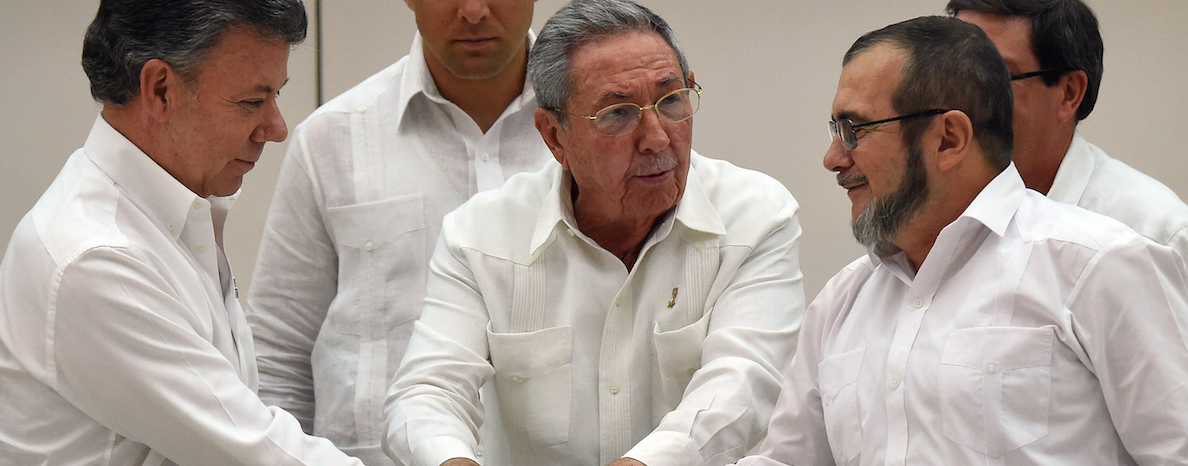Colombia’s march towards peace is slow and slippery. The blow suffered last autumn by President Juan Manuel Santos, when the majority of Colombians rejected the Havana agreements signed with FARC’s guerrillas with a referendum, was just the first serious pitfall.
The last, experienced mid-May, was a Constitutional Court ruling restricting the government’s ability to quickly approve the laws needed to implement the 300 page-long agreement. In between, a series of logistic delays, administrative quibbles, as well as political belligerence and rising insecurity have contributed to question whether peace will really come for the country that has already suffered 225,000 deaths, 45,000 desaparecidos and 7 million displaced people during its 52-year-long civil war.
President Santos has effectively paid no attention to the referendum’s outcome. He has kept on going following other paths, presenting the peace agreement in parliament in order to obtain its required legitimisation. After undergoing a series of amendments requested by the opposition, the text was approved. Santos’ determination has been rewarded with a Nobel Peace Prize. Such determination, however, is no longer sufficient, first of all because in order to implement a peace treaty one needs more than one man; one needs a state. One needs a state administration with its bureaucracy and logistic capabilities. The Colombian administration has clearly overestimated its operational simplicity and ability, considering that work on adapting the 26 Normalisation Transition Zones – in which FARC has been concentrated since February in order to start its transformation from an armed group to a political party – has suffered terrible delays.
According to the timeframe agreed upon, the 7,000 rebels who have arrived in these demobilisation and disarming areas should have left them on June 1st to return to civilian life. However, the delays accumulated by the government in creating dining facilities, training schools, medical clinics and other infrastructures for the guerrillas are so many and so serious that they have caused a domino effect slowdown in FARC’s gradual handing over of weapons to the United Nations. All this to the extent that FARC, the government and the United Nations have been obliged to extend the deadline for disarmament by three weeks and the existence of the Normalisation Transition Zones by two months.
On the other hand, the security situation in the country is such that the guerrillas now fear leaving these UN supervised areas. While the ceasefire between the Colombian Army and FARC has contributed to making 2016 the year with the lowest murder rate for the past 40 years (12,000 cases), there is one kind of murder in particular that has increased, that of social leaders and human rights defenders. Since the peace agreement was signed last November 24th, an activist has been killed every four days. According to some experts, this is a significant increase that proves that in Colombia there are forces that oppose the peace process, attacking those trying to promote it. Furthermore, quite a significant part of these murders occur in areas once controlled by FARC and that are now experiencing increased insecurity. Criminal gangs, paramilitary groups, FARC dissidents, clans of drug-traffickers and rebels belonging to the National Liberation Army (ELN) are occupying some of these areas in an attempt to grab some of the criminal business left behind by FARC, devoting themselves to extortion, cocaine trafficking and illegal mining. The Defence Ministry reports that it has deployed 65,000 soldiers and police officers to former FARC territories. For the moment, however, the inhabitants of regions such as Chocò, Nariño, Putumayo and Guaviare still live in fear and violence instead of peace.
As also underlined in the report entitled “Como va la paz” [How is peace going] published by the think tank Paz y Reconcilación, the state’s slowness in implementing the agreements is creating uncertainty in FARC’s base and society in general, with people beginning to question the state’s ability to honour its word given in Havana. Such uncertainty has been significantly increased by the Constitutional Court’s May ruling that crippled the fast tracking of laws linked to the peace agreement, allowing parliament to implement amendments. Furthermore, the legislative process was already rather slow and of the 27 initiatives contemplated by the government, only ten have been tabled so far, of which only four have been approved. The Constitutional Court’s ruling now risks slowing down the process even more and provides a helping hand to political parties wishing to sabotage the current peace agreement, such as the Democratic Centre led by former President Alvaro Uribe.
The complex situation is now also facing complications posed by the imminent election campaign with a general and a presidential election scheduled for spring 2018. The result of these elections will depend greatly on the success or failure of the implementation of the peace agreement.
“The path towards peace is irreversible,” say optimists such as President Santos and FARC’s leader, Londono. What is certain is that, in spite of delays and traps, objectives unthinkable until a few years ago have been achieved over the past few months. Dissidence within FARC has been far more limited than expected, with only a few hundred guerrillas deciding to remain in the jungle to wage war and continue trafficking. Thanks to the strict hierarchy that exists in this movement, over 7,000 rebels have gathered in the Normalisation Transition Zones and handed over their weapons. Furthermore, some of them are having children for the first time in the history of this armed organisation, which for half a century had imposed birth control measures on its female members. Finally, until just a year ago the main players in Colombian drug trafficking, FARC members are now accompanying government officials to rural communities to persuade them to abandon coca and replace it with legal crops in exchange for economic benefits, technical assistance and infrastructure development. The road to peace is a winding one, but, for the moment, the will to follow it is robust.
Translated by Francesca Simmons


